Subdivisions of the Kingdom of Galicia and Lodomeria
The Kingdom of Galicia and Lodomeria, a crown land of Austria-Hungary, was subdivided into political districts (German: Bezirkshauptmannschaften) for administrative purposes, which were referred to in Polish as powiaty (administrative counties). When they were introduced in 1867 there were 74 of these administrative counties;[1] in 1900 there were 78 counties. The administrative counties were responsible for storing vital records. These counties were introduced following the 1867 December Constitution.

Prior to 1867, while a crown land the Austrian Empire and before that as part of the Habsburg monarchy, the kingdom had instead been divided into Kreise since the late 18th century, which from 1854 were subdivided into Bezirke (referred to as Amtsbezirke ('office districts'), to distinguish them from other types of Bezirk).
The Kingdom of Galicia and Lodomeria was the largest and most populous crown land of Cisleithania (i.e. the non-Hungarian parts of the Habsburg realms) between 1772 and 1918. More widely, the central European region of Galicia is today split between the modern states of Poland and Ukraine. Despite having passed through several intermediate states during the great wars of the 20th century, the regions have mainly preserved their territorial integrity and continue to demarcate the jurisdiction of local government authorities in their successor states.
Kreise (until 1867)

The Kreise (lit. 'circles'; SG Kreis; Polish: cyrkuły, SG cyrkuł; Ukrainian: округи okruhy, SG округ okruh) of Galicia and Lodomeria go back in some form to the aftermath of the First Partition of Poland in 1772 which led to the Kingdom's creation, but did not take something resembling their final form until 1782. They were (generally) named after their capital/seat; usually this would take the form [genitival adjectival form of the name] Kreis (usually simply [Name]er Kreis e.g. Lemberger Kreis from Lemberg, the German name for Lviv), but Kreis [standard form of the name] (e.g. Kreis Lemberg) was also used, especially later, and the two forms were interchangeable.
At first, Galicia and Lodomeria was divided into 6 large Kreise, which were subdivided into 59 Kreisdistrikte ('circle districts') in 1773. In 1777 the number of Kreisdistrikte was reduced to 19.

In 1782 the two-level system was abolished and Galicia and Lodomeria was divided into 18 Kreise of the type used in the other non-Hungarian Habsburg realms (what would later be called Cisleithania). Over the next decade these would mostly take the forms which would persist until the mid-19th century.
As the border of Galicia and Lodomeria itself, the Vistula formed the northern borders of the Myslenicer, Bochnier, Tarnower and (partially) Rzeszower Kreise.
The Bukowiner Kreis (an exception where the name derives from the region, although it was also known as Czernowitzer Kreis) was added to Galicia and Lodomeria in 1786, having previously been a separate military district.
By the 1790s the Kreise were:[2]
- Myslenicer Kreis
- Bochnier Kreis
- Sandecer Kreis
- Tarnower Kreis
- Dukler Kreis
- Rzeszower Kreis
- Przemysler Kreis
- Sanoker Kreis
- Samborer Kreis
- Zamoscer Kreis
- Zołkiewer Kreis
- Lemberger Kreis
- Broder/Złozower Kreis
- Brzeczaner Kreis
- Tarnopoler Kreis
- Stryer Kreis
- Stanislauer Kreis
- Zalestschyker Kreis
- Czernowitzer/Bukowiner Kreis
The lands gained by the Habsburgs in the 1795 Third Partition of Poland became West (or New) Galicia, a separate part of the kingdom. It too was divided into Kreise; the western Mislenicer, Sandecer and Bochnier Kreise, which lay in the vicinity of the capital Krakau, were also attached to West Galicia. The area around Krakau on the right (southern) bank of the Vistula was transferred to the Krakauer Kreis. West Galicia was incorporated into Galicia-proper in 1803 as a semi-autonomous region.
West Galicia was largely bounded by the Vistula, Bug and Pilica rivers. The Vistula also formed the eastern border of the Radomer Kreis, the western border of the Josefower and Wiazownaer Kreise, the eastern and southern border of the Opatower Kreis, the southern border of the Stopnicer Kreis and part of those of the Slomniker and Krakauer Kreise.
The West Galician Kreise c. 1803:
- Krakauer Kreis (Kraków)
- Myslenicer Kreis (first partition)
- Sandecer Kreis (first partition)
- Bochnier Kreis (first partition)
- Slomniker Kreis
- Stopnicer Kreis
- Opatower Kreis (before 1789: Kreis Sandomierz)
- Konskier Kreis (Końskie)
- Radomer Kreis (Radom)
- Jozefower Kreis (Józefów)
- Lubliner Kreis (Lublin)
- Chełmer Kreis (or Chelmer Kreis) (Chełm)
- Bialer Kreis (Biała Podlaska)
- Siedlcer Kreis (Siedlce)
- Wiazown(a)er Kreis (earlier: Kreis Mińsk)
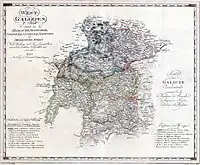
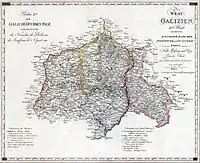
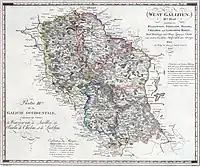
By the early 19th century the Dukler Kreis had become the Jasłoer Kreis when its capital moved there.
In 1804 the Habsburg monarchy, which until then had been de jure a collection of nominally separate states in a personal union under the Habsburg(-Lorraine)s, was formally united into the Austrian Empire, making Galicia and Lodomeria an Austrian crown land.
In 1809 the Treaty of Schönbrunn ceded the third-partition-territory plus the Zamośćer Kreis and an area around Krakau on the right bank of the Vistula to the Duchy of Warsaw,[3] a Napoleonic client. It also ceded the Tarnopoler Kreis and most of the Zalestschyker Kreis to the Russian Empire,[4] where they became the Tarnopolsky Krai. Most of the rump of Zalestschyker Kreis was merged with a part of the Stanislauer Kreis to become the Kolomeaer Kreis with the rest going to the Stanislauer Kreis itself.
The Tarnopolsky Krai was returned to Austria in 1815 (Congress of Vienna); the former Zalestschyker Kreis became the Czortkower Kreis. The area adjacent to Krakau on the right bank of the Vistula, which had been part of the Duchy of Warsaw, went to the Myslenicer and Bochnier Kreise, re-establishing the Vistula as the border. (The other territories which had been ceded to the Duchy of Warsaw on the other hand went to the Russian-controlled Congress Poland, other than the city of Kraków and its environs, which became the Free City of Cracow.)
In 1819 the Myslenicer Kreis became the Wadowicer Kreis.
The Free City of Cracow was annexed by Austria in 1846, nominally becoming the Grand Duchy of Kraków but administratively added to Galicia as the Krakauer Kreis. The extent of this Kreis, which matched that of the former free city, was similar but not identical to the earlier Krakauer Kreis of West Galicia.
The Bukowiner Kreis was detached as the Duchy of Bukovina in 1849.[5]
In 1850, following the Revolutions of 1848 the Kreise were abolished and replaced with a system of political districts (see § Regierungsbezirke and political districts (1850–53)) but these changes were reversed in Bach's reforms from 1853.[6] The changes to Galicia and Lodomeria were specifically laid out in 1854: they divided the crown land into two Verwaltungsgebiete (administrative regions/territories) based in Lemberg (Lviv/Lwów) and Krakau (Krawów), which each oversaw some of the land's Kreise; the two cities themselves were directly subordinate to the crown land. The Kreise were also subdivided into Bezirke ('districts'; also referred to as Amtsbezirke ('office districts')).[7]
In 1860 Verwaltungsgebiet Krakau and Bukovina were dissolved and re-subordinated to Lemberg; the Jasłoer Kreis was partitioned between the Sandecer, Tarnower, Rzeszower and Sanoker Kreise; the Wadowicer and Bochnier Kreise were merged into Kreis Krakau.[8] Bukovina was detached again in the 1861 February Patent.[9]
Below is a list of the divisions (Verwaltungsgebiete, Kreise and Bezirke) as of 1854,[7] with changes after that noted. (Divisions are listed with the names used in the legislation, i.e. mostly in contemporary German and/or Polish. Capitals are in bold.):
- City of Lemberg
- Verwaltungsgebiet Lemberg, containing the 12 eastern Kreise (1854–60[8]):
- Lemberger Kreis:
- Zołkiewer Kreis:
- Przemyśler Kreis:
- Sanoker Kreis:
- From 1860 also: Krosno, Żmigród and Dukla[8]
- Złoczower Kreis:
- Brzezaner Kreis:
- Stryier Kreis:
- Samborer Kreis:
- Tarnopoler Kreis:
- Czortkower Kreis:
- Kolomeaer Kreis:
- Stanislauer Kreis:
- 1860–61 Czernowitzer Kreis (Bukovina; capital Czernowitz; had also been part of Galicia and Lodomeria 1786–1849); Bezirke (from 1854):[10]
- Dorna
- Putilla
- Wysznitz
- Kimpolung
- Solka
- Gurahumora
- Sereth
- Waskoutz am Czeremosz
- Sadagura
- Storoschinetz
- Kotzmann
- Zastawna
- Suczawa
- Radautz
- Czernowitz (environs)
- City of Krakau
- Verwaltungsgebiet Krakau, containing the 7 western Kreise (1854–60[8]):
- Krakauer Kreis:
- Jaworzno
- Mogiła (today part of Kraków)
- Chrzanow
- Krzeszowice
- Liszki
- From 1860 also all of the Bezirke previously belonging to the Wadowicer and Bochniaer Kreise.[8]
- Wadowicer Kreis; in 1860 merged into the Krakauer Kreis;[8] Bezirke:
- Sandecer Kreis:
- From 1860 also: Gorlice and Biecz[8]
- Jasłoer Kreis; in 1860 split between the Sandecer, Tarnower, Rzeszower and Sanoker Kreise;[8] Bezirke:
- Rzeszower Kreis:
- From 1860 also: Strzyżów[8]
- Tarnower Kreis:
- From 1860 also: Brzostek, Frysztak and Jasło[8]
- Bochniaer Kreis (usually spelled Bochnier Kreis); in 1860 merged into the Krakauer Kreis;[8] Bezirke:
- Krakauer Kreis:
Regierungsbezirke and political districts (1850–53)
In 1850, in the aftermath of the revolutions of 1848, Galicia and Lodomeria was divided into three Regierungsbezirke ('government districts'), named after their capitals: Lemberg (Lviv/Lwów), Krakau (Krawów) and Stanislau (Stanislaviv/Stanisławów; today called Ivano-Frankivsk). The Kreise were abolished and replaced with political districts (Bezirkshauptmannschaften).[11] While political districts where also introduced in many other crown lands, they generally either retained their Kreise (often with a reduced number) or were not divided other than into political districts; the Regierungsbezirke were specific to Galicia and Lodomeria. This first attempt to introduce political districts to the Empire ended in 1853 with Bach's reforms.
- Regierungsbezirk Krakau, the area from the Carpathians to the Vistula, and the San basin (i.e. the area west of the San basin). Comprised the former Kreise of Krakau, Wadowice, Bochnia, Sandec, Jasło, Tarnów and Rzeszow, along with parts of the Sanok and Przemyśl Kreise. It had 26 districts:
- Krakau
- Chrzanow
- Podgórze
- Kenty
- Saybusch
- Wadowice
- Jordanow
- Neumarkt
- Dobczyce
- Bochnia
- Alt-Sandec
- Neu-Sandec
- Grybow
- Gorlice
- Jasło
- Tarnow
- Dombrowa
- Sędziszow
- Pilsno
- Mielec
- Dukla
- Krosno
- Rzeszow
- Łańcut
- Rozwadow
- Przeworsk
- Regierungsbezirk Lemberg – the former Kreise of Przemyśl, Zołkiew, Lemberg, Sanok, and Sambor, along with parts of the Stryi, Złoczow and Brzeżan Kreise. It had 19 districts:
- Dubiecko
- Jaroslau
- Przemyśl
- Jaworow
- Lubaczow
- Sambor
- Sanok
- Dobromil
- Stare Miasto
- Drohobycz
- Stryi
- Rawa
- Zołkiew
- Sokal
- Brody
- Lemberg
- Chodorow
- Grodek
- Złoczow
- Regierungsbezirk Stanislau – the former Kreise of Tarnopol, Czortkow, Stanislau and Kolomea, along with the remainder of the Stryi, Złoczow and Brzeżan Kreise. It had 18 districts:
- Załośce
- Tarnopol
- Skałat
- Bursztyn
- Brzeżan
- Podhayce
- Trembowla
- Czortkow
- Borszezow
- Buczacz
- Kałusz
- Dolina
- Stanislau
- Tyśmienica
- Nadworna
- Horodenka
- Kolomea
- Kuty
Political districts (from 1867)

In 1867 political districts (German: Bezirke, Polish: powiaty; also called counties (in the administrative sense) when translated from the Polish – see Powiat § Names and English equivalents) were reintroduced to Galicia and Lodomeria. They originally numbered 74:[1]
- Bezirk Krakau ; Powiat krakowski (Kraków)
- Bezirk Chrzanow ; Powiat chrzanowski (Chrzanów)
- Bezirk Wieliczka ; Powiat wielicki (Wieliczka)
- Bezirk Bochnia ; Powiat bocheński (Bochnia)
- Bezirk Brzesko ; Powiat brzeski (Brzesko)
- Bezirk Wadowice ; Powiat wadowicki (Wadowice)
- Bezirk Biała/Biala; Powiat bialski (Biała Krakowska, today part of Bielsko-Biała)
- Bezirk Saybusch ; Powiat żywiecki (Żywiec)
- Bezirk Myślenice ; Powiat myślenicki (Myślenice)
- Bezirk Neu Sandec ; Powiat nowosądecki (Nowy Sącz)
- Bezirk Neumarkt ; Powiat nowotarski (Nowy Targ)
- Bezirk Limanowa ; Powiat limanowski (Limanowa)
- Bezirk Grybow ; Powiat grybowski (Grybów)
- Bezirk Gorlice ; Powiat gorlicki (Gorlice)
- Bezirk Tarnow ; Powiat tarnowski (Tarnów)
- Bezirk Dąbrowa ; Powiat dąbrowski (Dąbrowa Tarnowska)
- Bezirk Mielec ; Powiat mielecki (Mielec)
- Bezirk Ropczyce ; Powiat ropczycki (Ropczyce)
- Bezirk Pilzno ; Powiat pilzneński (Pilzno)
- Bezirk Jasło ; Powiat jasielski (Jasło)
- Bezirk Rzeszow ; Powiat rzeszowski (Rzeszów)
- Bezirk Kolbuszow ; Powiat kolbuszowski (Kolbuszowa)
- Bezirk Tarnobrzeg ; Powiat tarnobrzeski (Tarnobrzeg)
- Bezirk Nisko ; Powiat niski (Nisko)
- Bezirk Łańcut ; Powiat łańcucki (Łańcut)
- Bezirk Sanok ; Powiat sanocki (Sanok)
- Bezirk Lisko ; Powiat liski (Lesko)
- Bezirk Bircza (Bircza); Bezirk Dobromil / Powiat dobromilski (Dobromyl) after 1876
- Bezirk Brzozow ; Powiat brzozowski (Brzozów)
- Bezirk Krosno ; Powiat krośnieński (Krosno)
- Bezirk Sambor ; Powiat samborski (Sambir)
- Bezirk Staremiasto (Stare Misto); Bezirk Stary Sambor / Powiat starosamborski / Старосамбірський повіт (Staryi Sambir) after 1899
- Bezirk Turka ; Powiat turczański (Turka)
- Bezirk Drohobycz ; Powiat drohobycki (Drohobych)
- Bezirk Rudki ; Powiat rudecki (Rudky)
- Bezirk Przemysl ; Powiat przemyski (Przemyśl)
- Bezirk Jaroslau ; Powiat jarosławski (Jarosław)
- Bezirk Mościska ; Powiat mościski (Mostyska)
- Bezirk Jaworów ; Powiat jaworowski (Yavoriv)
- Bezirk Lemberg ; Powiat lwowski; Львівський повіт (Lviv)
- Bezirk Grodek ; Powiat gródecki (Horodok)
- Bezirk Żółkiew ; Powiat żółkiewski (Zhovkva)
- Bezirk Sokal ; Powiat sokalski (Sokal)
- Bezirk Rawa ; Powiat rawski (Rava-Ruska)
- Bezirk Cieszanów ; Powiat cieszanowski (Cieszanów)
- Bezirk Brzeżan ; Powiat brzeżański (Berezhany)
- Bezirk Bobrka ; Powiat bóbrecki (Bibrka)
- Bezirk Rohatyn ; Powiat rohatyński (Rohatyn)
- Bezirk Podhajce ; Powiat podhajecki (Pidhaitsi)
- Bezirk Przemyslany ; Powiat przemyślański (Peremyshliany)
- Bezirk Stryj ; Powiat stryjski (Stryi)
- Bezirk Dolina ; Powiat doliński (Dolyna)
- Bezirk Kałusz ; Powiat kałuski (Kalush)
- Bezirk Zydaczow ; Powiat żydaczowski (Zhydachiv)
- Bezirk Stanislau ; Powiat stanisławowski; Станиславівський повіт (Stanisławów/Stanyslaviv; modern Ivano-Frankivsk)
- Bezirk Bohorodczany ; Powiat bohorodczański (Bohorodchany)
- Bezirk Nadworna ; Powiat nadwórniański (Nadvirna)
- Bezirk Tłumacz ; Powiat tłumacki; Тлумацький повіт (Tlumach)
- Bezirk Buczacz ; Powiat buczacki; Бучацький повіт (Buchach)
- Bezirk Kołomea ; Powiat kołomyjski; Коломийський повіт (Kolomyia)
- Bezirk Horodenka ; Powiat horodeński (Horodenka)
- Bezirk Sniatyn ; Powiat śniatyński; Снятинський повіт (Sniatyn)
- Bezirk Kossow ; Powiat kosowski (Kosiv)
- Bezirk Zaleszczyk ; Powiat zaleszczycki; Заліщицький повіт (Zalishchyky)
- Bezirk Borszczow ; Powiat borszczowski; Борщівський повіт (Borshchiv)
- Bezirk Husiatyn ; Гусятинський повіт; Гусятинський повіт (Husiatyn)
- Bezirk Czortków ; Powiat czortkowski; Чортківський повіт (Chortkiv)
- Bezirk Tarnopol ; Powiat tarnopolski; Тернопільський повіт (Ternopil)
- Bezirk Zbaraż ; Powiat zbaraski; Збаразький повіт (Zbarazh)
- Bezirk Skałat ; Powiat skałacki; Скалатський повіт (Skalat)
- Bezirk Trembowla ; Powiat trembowelski; Теребовлянський повіт (Terebovlia)
- Bezirk Złoczow ; Powiat złoczowski (Zolochiv)
- Bezirk Brody ; Powiat brodzki (Brody)
- Bezirk Kamionka Strumiłowa ; Powiat kamionecki (Kamianka-Buzka)
Some other districts were created later:
- Bezirk Strzyżów (Strzyżów) and Bezirk Podgórze (Podgórze) in 1896
- Bezirk Peczeniżyn (Pechenizhyn) in 1898
- Bezirk Przeworsk (Przeworsk) in 1899
- Bezirk Zborów (Zboriv) in 1904
- Bezirk Oświęcim/Auschwitz (Oświęcim) in 1910
- Bezirk Skole (Skole) in 1911
- Bezirk Radziechów (Radekhiv) in 1912
In 1902 the Galician-Hungarian border was adjusted slightly, now running along the mountain ridge through the peak of Rysy; prior to this it had run through the Morskie Oko lake about a kilometre to the west. This therefore slightly expanded Neumarkt/Nowy Targ district.
Later History
Interwar period
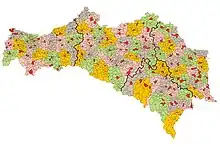
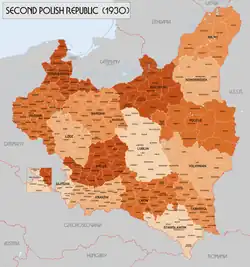
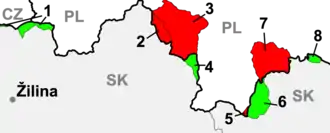
During the Interwar period what had been Galicia and Lodomeria became part of the Second Polish Republic. Its territory became the Kraków, Lwów, Tarnopol and Stanisławów Voivodeships. For the most part the former political districts were transitioned directly into Polish powiats (counties or districts). Kraków Voivodeship (specifically Nowy Targ powiat, which corresponds to the modern Nowy Targ and Tatra powiats) also contained a small amount of territory annexed from Hungary (Jabłonka and Nowa Biała), which would become a border conflict with Czechoslovakia.
In 1938 some additional territories along what was by this time the Polish-Czechoslovak border were ceded to Kraków Voivodeship: Javorina and Lesnica.
World War II

In 1939 at the beginning of World War II Poland was jointly occupied and annexed by Nazi Germany and the Soviet Union in accordance with the Molotov–Ribbentrop Pact. Most of the western parts of the former Galicia and Lodomeria became part of the Nazi General Government, largely forming the Kraków District (Distrikt Krakau), although some additional areas north of Kraków (most of which had incidentally been part of West Galicia) were also included; the northeastern border lay along the San, placing a small part of it in the Lublin District (Distrikt Lublin). The parts furthest to the west became part of Germany-proper within the East Upper Silesia area of Upper Silesia Province. The border between the General Government and what was by this time the Slovak State was restored to that of the pre-1918 Galicia-Hungary border.
The Soviet-annexed formerly Galician territories became the Drohobych, Lviv, Stanislav (now Ivano-Frankivsk) and Tarnopil Oblasts of the Ukrainian SSR, which broadly correspond with the modern Lviv, Ivano-Frankivsk and Ternopil Oblasts (see below).
In July 1941 as part of the Nazi invasion of the Soviet Union the rest of the former Galicia and Lodomeria was annexed by Germany. Some western parts of this territory became part of the Kraków District while the rest formed the District of Galicia (Distrikt Galizien), which also gained a small amount of formerly Galician territory from the Lublin District which had been on the German-side of the 1939 border. The external borders of the District of Galicia (other than with the Kraków District) matched those of the former kingdom.
Modern divisions
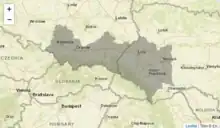
Administrative divisions in present-day Poland
In Poland today, there are parts of three voivodeships (provinces) that collectively formed the western part of the Kingdom of Galicia and Lodomeria.[12]
Only Podkarpackie Voivodeship ("Subcarpathia") was entirely contained in the Kingdom. The majority of the territory of the Lesser Poland Voivodeship was contained in the Kingdom. From 1795 to 1815, three counties (powiats) that are situated north of the river Vistula were briefly part of the Kingdom: Olkusz County, Miechów County and Proszowice County. By the terms of the treaties of the Congress of Vienna they were annexed to Russian Poland ("Congress Poland") where they remained until the end of World War I. Additionally, the northernmost part of the land-county of Kraków around the villages of Sułoszowa, Skała and Słomniki were similarly allocated to Congress Russia; the remaining parts of the county were located in the Kingdom. The third voivodeship of Silesia contained only a small part of the Kingdom. The Silesian city-county of Jaworzno was originally part of the Kingdom's Chrzanowski county. The majority of the territory of the latter county is still an extant county in modern Poland – Chrzanów County – which is today located in the Lesser Poland voivodeship. The south-eastern Silesian land-counties of Żywiec County and Bielsko County along with the city-county of Bielsko-Biała formed the most westerly part of the Kingdom. The remaining 32 counties of Silesia were never part of the Kingdom.
| Modern Provincial Entity | Modern Counties of the Province |
Equivalent Counties of Galicia |
|---|---|---|
| Lesser Poland Voivodeship | ||
| Kraków (city-county) | Kraków | |
| Tarnów (city-county) | Tarnów | |
| Nowy Sącz (city-county) | Nowy Sącz | |
| Kraków County | Partly in Kraków and partly in Wadowice | |
| Nowy Sącz County | Partly in Nowy Sącz, Grybów and Muszyna | |
| Tarnów County | Partly in Tarnów and Pilzno | |
| Nowy Targ County | Nowy Targ (northern part) | |
| Wadowice County | Wadowice | |
| Oświęcim County | Partly in Biala and partly in Wadowice | |
| Chrzanów County | Chrzanów | |
| Limanowa County | Limanowa | |
| Myślenice County | Myślenice eastern part) | |
| Gorlice County | Gorlice | |
| Wieliczka County | Wieliczka | |
| Bochnia County | Bochnia | |
| Brzesko County | Brzesko | |
| Sucha County | Myślenice western part) | |
| Tatra County | Nowy Targ (southern part) | |
| Dąbrowa County | Dąbrowa | |
| Silesian Voivodeship | ||
| Jaworzno (city-county) | Chrzanów (western part) | |
| Bielsko-Biała (city-county) | Biala | |
| Bielsko County | Biala | |
| Żywiec County | Żywiec | |
| Subcarpathia voivodeship | ||
| Rzeszów city-county | Rzeszów (partly) | |
| Przemyśl city-county | Przemyśl | |
| Tarnobrzeg city-county | Tarnobrzeg (part of) | |
| Krosno city-county | Krosno | |
| Rzeszów County | Rzeszów (partly) | |
| Mielec County | Mielec | |
| Dębica County | Pilzo (partly) | |
| Jarosław County | Jarosław (eastern part) | |
| Jasło County | Jasło | |
| Krosno County | Krosno | |
| Lubaczów County | Lubaczów | |
| Stalowa Wola County | Northern part in Tarnobrzeg and southern part in Nisko | |
| Sanok County | Sanok | |
| Przeworsk County | Jarosław (western part) | |
| Łańcut County | Łańcut (south of the river Wisłoka) | |
| Ropczyce-Sędziszów County | Ropczyce | |
| Przemyśl County | Przemyśl (To the north) and Dobromil (To the south) | |
| Leżajsk County | Łańcut (north of the river Wisłoka) | |
| Nisko County | Nisko | |
| Brzozów County | Brzozów | |
| Strzyżów County | Strzyżów | |
| Kolbuszowa County | Kolbuszowa | |
| Tarnobrzeg County | Tarnobrzeg (western part) | |
| Lesko County | Lesko (western part) | |
| Bieszczady County | Lesko (eastern part) (Ceded by the USSR) | |
Administrative raions in present-day Ukraine
In Ukraine today, there are three provinces (oblasts) that formed the eastern part of the Kingdom of Galicia and Lodomeria. Two of these – Lviv Oblast and Ivano-Frankivsk Oblast – were entirely contained in the kingdom. The third – Ternopil Oblast – was mainly in the kingdom apart from four of its most northerly raions. These four raions – Kremenets Raion, Shumsk Raion, Lanivtsi and the northern half of Zbarazh Raion – were formerly part of the county of Krzemieniec in the Wolyn Voivodeship (province) of the Second Polish Republic during the interwar period. Prior to World War I, they were part of Congress Poland. They never formed part of the Kingdom of Galicia and Lodomeria. The remaining raions of Ternopil Oblast were all part of the Kingdom of Galicia and Lodomeria.
| Modern Oblast of Ukraine |
Modern Raions of the Oblast |
Equivalent political districts of Galicia |
|---|---|---|
| Lviv Oblast | Brody Raion | Southern part of Brody district. |
| Brody city-district | Brody | |
| Busk Raion | Złoczów | |
| Busk city-district | Złoczów | |
| Drohobych Raion | Drohobycz | |
| Drohobych city-district | Drohobycz | |
| Horodok Raion | Grodek (southern part) and Rudky (southern part) | |
| Kamianka-Buzka Raion | Kamionka | |
| Mostyska Raion | Mosciska | |
| Mykolaiv Raion | Żydaczów (Only the northern part of the district.) | |
| Peremyshliany Raion | Przemyślany and the northern part of Bóbrka | |
| Pustomyty Raion | Lviv district | |
| Radekhiv Raion | Northern part of Brody district and northern part of Kamionka. | |
| Sambir Raion | Sambor and Rudky | |
| Skole Raion | All of the old district of Stryj south of modern Stryi Raion. | |
| Sokal Raion | To the north Sokal and To the south Rawa-Ruska. | |
| Staryi Sambir Raion | Stari Sambor | |
| Stryi Raion | Stryj (Only the northern part of the district.) | |
| Turka Raion | Turka | |
| Yavoriv Raion | Jaworów and Grodek (northern part) | |
| Zhovkva Raion | To the north Rawa-Ruska and To the south Żółkiew | |
| Zhydachiv Raion | Żydaczów (Excluding the northern part of the district.) | |
| Zolochiv Raion | Eastern part of Żółkiew district and western part of Peremyshliany. | |
| Ivano-Frankivsk Oblast | ||
| Bohorodchany Raion | ||
| Verkhovyna Raion | ||
| Verkhovyna | ||
| Halych Raion | Stanislavov | |
| Halych (City) | ||
| Horodenka Raion | ||
| Horodenka (City) | ||
| Dolyna Raion | ||
| Dolyna (City) | ||
| Kalush Raion | ||
| Kalush (City) | ||
| Kolomyia Raion | ||
| Kolomyia (City) | ||
| Kosiv Raion | ||
| Kosiv (City) | ||
| Nadvirna Raion | ||
| Nadvirna (City) | ||
| Rohatyn Raion | ||
| Rohatyn (City) | ||
| Rozhniativ Raion | ||
| Rozhniativ (City) | ||
| Sniatyn Raion | ||
| Sniatyn (City) | ||
| Tysmenytsia Raion | ||
| Tysmenytsia (City) | ||
| Tlumach Raion | ||
| Tlumach (City) | ||
| Ternopil Oblast | ||
| Berezhany Raion | Western part of Brzeżany district. | |
| Borshchiv Raion | Borszczów | |
| Buchach Raion | Buczacz district | |
| Chortkiv Raion | Czortków and the southern part of Kopychyntsi district | |
| Husiatyn Raion | Kopychyntsi | |
| Kozova Raion | Eastern part of Brzeżany district except for the city of Brzeżany itself. | |
| Monastyryska Raion | Western part of Buczacz district. | |
| Pidhaitsi Raion | Western part of Podhajce district. | |
| Pidvolochysk Raion | Skalat district and the eastern part of Zbaraż district | |
| Terebovlia Raion | Trembowla district in the east and Podhajce district in the west. | |
| Ternopil Raion | Tarnopol district | |
| Zalishchyky Raion | Zalishchyky | |
| Zbarazh Raion | The western part of Zbaraż district and the southern part of Brody district. | |
| Zboriv Raion | Zborów district | |
Carpathian Ruthenia, today largely contained in the Ukrainian oblast of Zakarpattia, was never part of the Kingdom of Galicia and Lodomeria nor of modern Poland. Instead, it was part of transleithanian lands of the Kingdom of Hungary.
Jewish Administrative Centers
The government assigned some towns the status of Jewish Administrative Center. These Administrative Centers were responsible for maintaining Jewish vital records.
References
- Gesetz vom 23. Jänner 1867, RGBl. 17/1867: "Verordnung des Staatsministeriums vom 23. Jänner 1867, über die Reform der politischen Verwaltung in den Königreichen Galizien und Lodomerien mit dem Großherogthume Krakau und den Herzogthümern Auschwitz und Zator". Reichs-Gesetz-Blatt für das Kaiserthum Österreich (in German). 1801-01-23. Retrieved 2023-07-08 – via ÖNB-ALEX - Historische Rechts- und Gesetztexte Online.
- Regna Galiciae, et Lodomeriae Iosephi II. et M. Theresiae Avgg. Ivssv methodo astronomico trigonometrica, nec non Bukovina geometrice dimensa : Adjectus est alphabeticus locorum, et Quadratulorum, ipsis in Tabula Geographica respondentium index, Seorsum typis datus – Trigonometric map of Galicia and Lodomeria by Joseph Liesganig, 1794. Available from the National Library of Poland here. A version coloured to show the post-1815 Kreise is also available here
- . 1809-10-14. – via Wikisource.
- . 1809-10-14. – via Wikisource.
- Gesetz vom 13. März 1849, RGBl. 163/1849: "Erlaß des Ministeriums des Innern vom 13. März 1849, womit die Stellung und der Wirkungskreis des k. k. Kreishauptmannes zu Czernowitz, als provisorischer Landeschef des Kronlandes Bukowina, festgesetzt wird". Reichs-Gesetz-Blatt für das Kaiserthum Österreich (in German). 1849-03-13. Retrieved 2023-07-09 – via ÖNB-ALEX - Historische Rechts- und Gesetztexte Online.
- Gesetz vom 19. Jänner 1853, RGBl. 10/1853: "Verordnung der Minister des Inneren, der Justiz und der Finanzen vom 19. Jänner 1853, womit die Allerhöchsten Entschließungen über die Einrichtung und Amtswirksamkeit der Bezirksämter, Kreisbehörden und Statthaltereien, über die Einrichtung der Gerichtsstellen und das Schema der systemisirten Gehalte und Diätenclassen, sowie über die Ausführung der Organisirung für die Kronländer Oesterreich ob und unter der Enns, Böhmen, Mähren, Schlesien, Galizien und Lodomerien mit Krakau, Bukowina, Salzburg, Tirol mit Vorarlberg, Steiermark, Kärnthen, Krain, Görz, Gradiska und Istrien mit Triest, Dalmatien, Kroatien und Slawonien, Siebenbürgen, die serbische Wojwodschaft mit dem Banate, kundgemacht werden". Reichs-Gesetz-Blatt für das Kaiserthum Österreich (in German). 1853-01-19. Retrieved 2023-07-07 – via ÖNB-ALEX - Historische Rechts- und Gesetztexte Online.
- Gesetz vom 24. April 1854, RGBl. 111/1854: "Verordnung der Minister des Innern, der Justiz und der Finanzen vom 24. April 1854, betreffend die politische und gerichtliche Organisirung der Königreiche Galizien und Lodomerien mit dem Großherzogthume Krakau und den Herzogthümern Auschwitz und Zator". Reichs-Gesetz-Blatt für das Kaiserthum Österreich. 1854-04-24. Retrieved 2023-07-06 – via ÖNB-ALEX - Historische Rechts- und Gesetztexte Online.
- Gesetz vom 6. August 1860, RGBl. 198/1860: "Verordnung der Ministerien des Innern und der Justiz vom 6. August 1860, giltig für das Königreich Galizien mit dem Großherzogthume Krakau und für das Herzogthum Bukowina, womit der Zeitpunct der Einstellung der Amtswirksamkeit der Landesregierungen in Krakau und Czernowitz, sowie der Landes-Bauhehörden daselbst, dann der Kreisbehörden in Wadowice, Bochnia und Jasło, ferner der Beginn der Wirksamkeit der Kreisbehörde in Czernowitz bekannt gegeben, und die aus diesem Anlasse in politischer und gerichtlicher Beziehung erforderlichen Uebergangsbestimmungen erlassen werden". Reichs-Gesetz-Blatt für das Kaiserthum Österreich (in German). 1860-08-06. Retrieved 2023-07-04 – via ÖNB-ALEX - Historische Rechts- und Gesetztexte Online.
- Patent vom 28. Februar 1861, RGBl. 20/1861: "February Patent". Reichs-Gesetz-Blatt für das Kaiserthum Österreich. 1861-02-28. Retrieved 2023-07-06 – via ÖNB-ALEX - Historische Rechts- und Gesetztexte Online.
- Gesetz vom 24. April 1854, RGBl. 110/1854: "Verordnung der Minister des Innern, der Justiz und der Finanzen vom 24. April 1854, betreffend die politische und gerichtliche Organisirung des Herzogthumes Bukowina". Reichs-Gesetz-Blatt für das Kaiserthum Österreich. 1854-04-24. Retrieved 2023-07-06 – via ÖNB-ALEX - Historische Rechts- und Gesetztexte Online.
- Gesetz vom 8. October 1850, RGBl. 383/1850: "Verordnung des Ministeriums des Innern vom 8. October 1850, wodurch die von Seiner Majestät sanctionirte Organisation der politischen Verwaltung der Königreiche Galizien und Lodomerien mit den Herzogthümern Auschwitz und Zator und dem Großherzogthume Krakau kundgemacht wird". Reichs-Gesetz-Blatt für das Kaiserthum Österreich. 1850-10-08. Retrieved 2023-07-06 – via ÖNB-ALEX - Historische Rechts- und Gesetztexte Online.
- "Galician Distant Cousins". Archived from the original on 2006-08-15.
Further reading
- 1877 Galician Administrative Districts from JewishGen
- 1900 Galicia: Administrative Districts from PolishRoots
- 74 Administrative Districts in Galicia
- Galician Administrative Districts from The Polish Genealogical Society of America